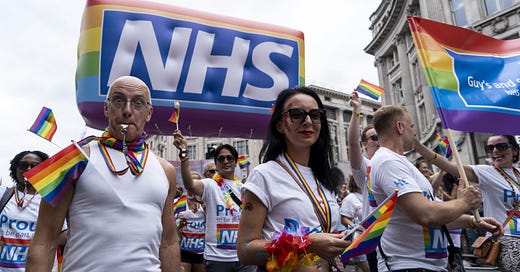What has “gender identity” got to do with the NHS?
Doctors should not concern themselves with the metaphysical beliefs of patients.
The Cass Report has already proved to be a wrecking ball to the delicate piñata of gender identity ideology. Not before time, the Health Secretary Victoria Atkins has announced that the activist lexicon which has inveigled itself into NHS guidelines will now be weeded out. If all goes to plan, the NHS will no longer be referring to “chestfeeders”, or avoiding the dreaded terms “woman” and “mother” in favour of grimly misogynistic alternatives such as “people who have ovaries” or “birthing parents” or, as Titania McGrath once suggested, “bipedal gestation units”.
In addition, women will now be accommodated on single-sex wards. Most patients will have assumed that this was official policy already, but there was a rather shocking fudge in the early days of its implementation. When in 2010 the Health Secretary Andrew Lansley announced that NHS wards must be segregated by sex, there were internal memos that made it clear to staff that the real determining factor would be “gender”. A leaked document from the NHS Information Standards Board for Health and Social Care explicitly stated that “the policy commitment relates to gender, not sex, but to ensure a better public understanding it is referred to as Mixed-Sex Accommodation (MSA)”. The public were to be deliberately misled, and this was coming from the very top.
The consequences of this fealty to gender identity ideology proved to be severe. In March 2022, I spoke to Baroness Emma Nicholson about an alleged rape on a hospital ward. The crime was shocking enough, but when police turned up to investigate, they were told by members of staff that there were no men on the single-sex ward, and “therefore the rape could not have happened”. This was not simply the poor behaviour of a rogue nurse, but was in adherence to an actual NHS policy known as “Annex B”. The NHS was accommodating patients by “gender identity”, not biological sex, and if a female patient complained that there was a man on her ward, she was to be told that this simply wasn’t true.
My full interview with Baroness Nicholson is here:
Thanks to the Cass Review, we are finally seeing these terrible mistakes being rectified, and NHS is finally rowing back from these turbid waters. But while these changes are to be welcomed, we are at risk of overlooking one key question: how on earth did we find ourselves in this position in the first place? The influence of activists on our major institutions has been so surreptitious and rapid that we haven’t had time to reflect on why it happened at all.
Let’s not forget that we are dealing here with an essentially religious premise: that each of us has a “gender identity”, a mysterious male or female essence, that does not necessarily align with our anatomy. In all the frenetic chaos of the culture wars, it is difficult to remain objective. But make no mistake: this situation is bizarre and unprecedented. It would be like the NHS introducing opening an “exorcism ward” to treat those suffering from psychotic episodes.
Keep reading with a 7-day free trial
Subscribe to Andrew Doyle to keep reading this post and get 7 days of free access to the full post archives.




